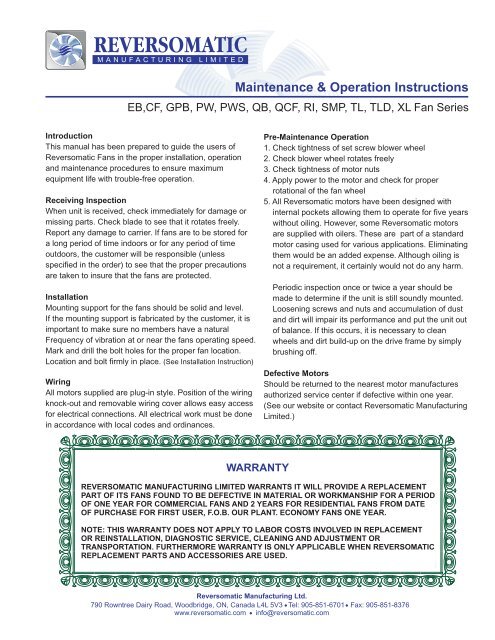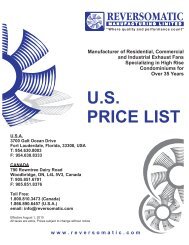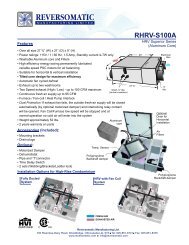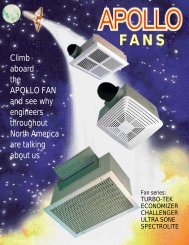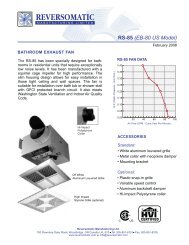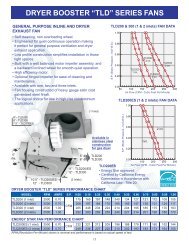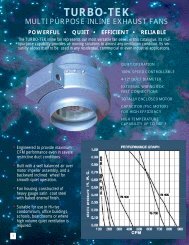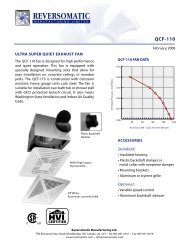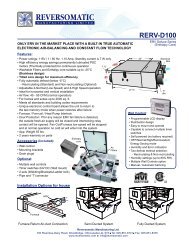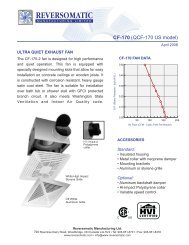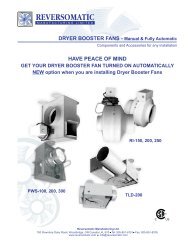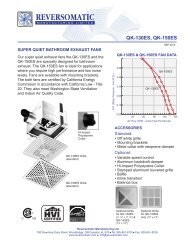Warranty, Maintenance & Operation Instructions - Reversomatic
Warranty, Maintenance & Operation Instructions - Reversomatic
Warranty, Maintenance & Operation Instructions - Reversomatic
Create successful ePaper yourself
Turn your PDF publications into a flip-book with our unique Google optimized e-Paper software.
INSTALLATION & MAINTENANCE GUIDEA, AF, BEA, BES, FA, H, RBD, RDD, RE, RHE, RHS, UBA, UBD, UBS, UDD General <strong>Instructions</strong>REGULAR MAINTENANCE / LUBRICATION OF THIS UNIT IS REQUIREDTO MAINTAIN THE MANUFACTURER’S WARRANTY.FOR MOTORS LARGER THAN 7 ½ HP, AN ELECTRONIC “SOFT START”CONTROL IS RECOMMENDED FOR LONGER BELT LIFE.C A U T I O NIT IS STRONGLY RECOMMENDED THAT BEFORE STARTING UPTHE FAN THE FOLLOWING INSPECTIONS ARE PERFORMED.1. FAN BELT (IF USED) TIGHTNESS AND ALIGNMENT.2. FAN BLADE CENTERING AND ROTATION.3. FAN BLADE MOUNTING BOLT TIGHTNESS.4. MOTOR MOUNTING PLATE BOLT TIGHTNESS.5. BEARING LUBRICATION.WARNINGS AND SAFETY INSTRUCTIONS1. Do not operate the fan excess of maximum limit.2. Do not permit any object to enter the fan inlets or outlets; provide a screen covering.3. Do not operate the fan without adequate guards over rotating parts; provide drive belt,coupling and shaft guards.4. Provide a disconnect switch with a padlock to prevent fan switch use during maintenance.5. Locate a disconnect switch at the fan for use of personnel working on the fan.6. Provide vibration limiting switches to detect sudden changes in the operation of the fan,especially when operating a fan under high temperatures or in an extremely corrosiveatmosphere such as fly ash.7. Lubricate and service bearings regularly. see lubrication schedule.J.TANTAY 01.14.10<strong>Reversomatic</strong> Manufacturing Ltd.790 Rowntree Dairy Road, Woodbridge, ON, Canada L4L 5V3 Tel: 905-851-6701 Fax: 905-851-8376www.reversomatic.com info@reversomatic.com
Performance Problems:INSTALLATION & MAINTENANCE GUIDECFM too low - These are some common sources of this problem:Fan - forward curved impeller installed backwards, fan running backwards, cutoff missing or improperly installed, impeller not centered with inletcollars, fan speed too slow.System - more resistant to flow than expected, dampers or registers closed, leaks in supply ducts, insulating duct liner loose, clogged filters or coils.Fan Inlets - leaks around fan inlets, elbows near the inlet, cabinet walls too close. Inlet obstructions cause more restrictive systems but do notcause increased negative pressure readings near the fan inlets. Fan speed may be increased to counteract the effect of restricted faninlet, but check the maximum RPM for the wheel construction before increasing the speed.Fan Outlet - most centrifugal fans are used in ducted systems and have been tested with a length of straight duct at the fan outlet, If there is nostraight duct at the fan outlet, decreased fan performance will result. If it is not practical to install a straight section of duct at the fanoutlet, the fan speed may be increased to overcome this pressure loss. Other sources affecting fan outlet may be sharp elbow nearby,improperly designed turning vanes or other obstructions near the outlet.Noise - may be caused by:a. Impeller hitting the inlet of the fan or cutoff plate, loose impeller.b. Drives can cause noise if sheaves are not tight on the shaft, belts are too loose or too tight, wrong belt cross section, or mis-matchedbelts, also worn belts, oily belts or mis-aligned sheaves.c. If couplings are used they may be source of noise by being unbalanced, misaligned, loose or dry of lubricant.d. Bad bearings are a common source of noise when defective, dry of lubricant, loose on the bearing support, loose on the shaft,seals mis-aligned, dirty lubricant, fretting corrosion between inner race and shaft, etc. See separate section on bearing care.e. There can be an electrical source of noise such as AC hum in motor or relay, starting relay chatter, noisy motor bearings, single phasinga 3 phase motor, etc.f. A bent or undersized shaft may be a noise source. IF MORE THAN TWO BEARINGS ARE ON THE SAME SHAFT, THEY MUST BECAREFULLY ALIGNED.g. There may be other noise sources such s obstruction in high velocity air stream causing rattle or pure tone whistle, fan operating atundesirable design point, causing pulsation, cracks or holes in duct work, or whistles in fan housing.LUBRICATIONTROUBLESHOOTING LISTRELUBRICATION SCHEDULE (MONTHS)*Ball Bearing Pillow Blocks*Suggested initial greasing interval - relubricate while running, if safety permits, until some purgingoccurs at seals. Adjust lubrication frequency depending on condition of purged grease. Hours ofoperation, temperature, and surrounding conditions will affect the relubrication frequency required.1. Lubricate with a high quality NLGI No. 2 or No.3 multi purpose ball bearing grease having rustinhibitors and anti-oxidant additives.Some grease having these properties are:• Shell - Alvania EP No.2 • Mobil - Mobilux Ep2• Gulf - Gulfcrown No. 2 • American - Amolith No. 2• Texaco - Molytex No.22. Lubricate bearings prior to extended shutdown or storage and rotate shaft monthly to avoidcorrosion.Spherical Roller Bearings - Solid Pillow BlocksIMPELLERDRIVECOUPLINGBEARINGSHAFTMOTORa. Loose on shaftb. Unbalancea. Sheave not tight on shaft (motor or fan)b. Belts hitting belt tube or belt guardc. Belts too loose. Adjust for belt stretching after48 hours of operation.d. Belts too tighte. Belts wrong cross-sectionf . Belts not “Matched” in length on multi-belt driveg. Variable pitch sheaves not adjusted so each groovehas same pitch diameter (multi-belt drive)h. Misaligned sheavesI . Belts wornj . Motor, Motor base or fan not securely anchoredk. Belts oily or dirtyl . Improper drive selectionm. loose keyn. Excessive start-stop cyclesa. Coupling unbalanced, misaligned, loose or mayneed lubricantb. Loose keya. Defective bearingb. Needs lubricationc. Loose on bearing supportd. Loose on shafte. Seals misalignedf . Foreign material inside bearingg. Worn bearingh. Fretting corrosion between inner race and shafti . Bearing not sitting on flat surfacej . Excessive belt tensiona. Bentb. Undersizeda. Noisy motor bearingsb. Single phasing a three phase motorc. Low voltage1. Lubricate with a multi-purpose roller bearing NLGI grade 2 grease having rust inhibitors, anti-oxidantadditives, and a minimum oil viscosity of 500 SSU at 100 F. Some additives.Some grease having these properties are:• American - Rykon No.2 • Mobil - Mobilgrease 28 • Texaco - Molytex Ep2 grease2. Lubricate bearings prior to extended shutdown or storage and rotate shaft monthly to avoidcorrosion.RECOMMENDED ‘SKF’ GREASES FOR ‘SKF’ BEARINGSFixed Pillow Block - LGMT2 Fans running below 80 c (176 f)Split Pillow Block - LGMT3 Fans running below 80 c (176 f)Fans Running Above 80 c thru 150 c - LGHT3LOOSE FASTENERSa. Impeller set screwsb. Bearing set screwsc. Drive component set screwsd. Fan mounting boltse. Bearing boltsf . Motor boltswww.reversomatic.cominfo@reversomatic.comj.tantay 08.27.10


